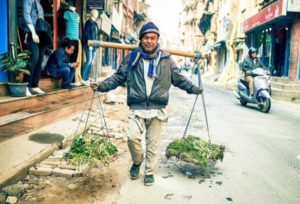
Mohandas Tripathi was born in an upper class Hindu- Brahmin family.
His great grandfather moved to Gangtok from Bihar even before Sikkim became a part of India, in search of work. Mohandas grew up in the beautiful hills of a cosmopolitan town that Gangtok is. He learnt Nepali and Bhutia along with his own mother tongue, preferred gundruk over litti and participated in Losar and Dassai as much as in Chatt Puja. Not once did he visit or bother knowing more about the village his family is supposed to hail from. All was fine until, he moved to Delhi for higher education. It was in college where he was exposed to the question, “What his actual identity was?” Was it enough to be just born in Sikkim for him to be called a Sikkimese? How could he be from Bihar when he has never visited the place? Where did Mohandas belong to?
Cases like the one stated above hold true for a lot of individuals, especially in a diverse country like ours. Individuals find it increasingly difficult to associate either with a single place or a particular culture. We assimilate into the culture we move into, and give bits and parts of the culture we carry with us to the new people we settle with. Nationality, linguistic boundaries and regional identities can no longer determine the characteristic features of a person or a community. Economic needs are leading to increasing social interaction, forcing every community to open its doors to the so- called ‘outsiders’. People have increasingly come to share what was once unique to them and in turn adopt several ‘alien practices’.
While it is still very difficult to accept the political presence of immigrants or refugees, people as host communities are quick to adopt the cultural practices brought by them. Political tensions that exist between India, China and Pakistan are an ever-increasing threat of war lingering on our heads have made the people of India pretty hostile to people from our neighbouring land. The Tibetans who have migrated from China to states like Himachal Pradesh, Uttarakhand, Sikkim, Delhi and Jammu and Kashmir, and the Pakistani Sikhs and Hindus who are settled in the north-western part of the country since 1947, face constant social ostracization (if not political) based on factors such as tax exemptions, land encroachments or direct racial differences. In large part of Assam and West Bengal, Bangladeshi immigrants are looked down upon and hated for increasing economic competition. The intra-regional tolerance to immigration is also not very high; North Indians are always pitched against South Indians and North-East Indians are subject to constant racial discrimination and violence.
Despite all of these differences, how does our country then survive without breaking into hundred little sovereign parts? Perhaps, because it is not only people who migrate and take refuge in new lands but along with them comes their language, food, attire and religious practices. Now, while as host communities we conveniently ignore these people, ignoring the novelty of their culture becomes difficult. It is this process of adaptation and assimilation resulting in a cultural unity that becomes a greater force in keeping people together rather than the perceived nationalistic identity that each one of us has been labelled with.
How else do we explain the origin of the popular “desi-Chinese” cuisine, Momos being sold in every nook and corner of North India, dosa becoming the most favoured breakfast option of the country and the diverse plethora of food every Indian street has to offer. Not only food, textiles and fashion has also travelled across culture and regions and is worn irrespective of religion. Of course Bollywood plays an important role in integrating India’s fashion sense but we can often see women adorned in Pakistani suits and passa and men in pathanis; Phulkari from Punjab, Banarasi and Kanjivaram Silk, North-Eastern weaving, Kashmiri shawls and carpets and a never ending list of merchandise is widely consumed all over the country. If one has been lucky enough to have travelled to both Lahore and Amritsar, the person will not be able to distinguish between the cultures of these two places. These mortal enemies speak the same language, eat similar cuisine, dress the same way and Urdu is still written on various sign boards and hoardings in both these cities. Besides, who doesn’t love artists like Fawad Khan, Atif Aslam, Rahat Fateh Ali Khan or hasn’t swayed to the music produced by the Coke Studio. The mesmerising grace and teachings of Dalai Lama has had us intimidated at some point or the other. K-pop or popular Korean music and drama has been on a rise among small but intense fan groups especially in places like Shillong, Delhi and Chennai. Gorkhas who have recently been in news due to their demand for a separate state form a part of one of the most honoured regiment of the Indian Army.
Today, we might not think twice before calling a person from the north-east “chinki”, but at the very next instance we may land up in a Korean restaurant only to be served our much-loved delicacies. It is high time we prevent our mindless actions from disturbing this beautiful synergy of cultures and sharpening nationalistic differences. For all we know national boundaries have never been faithful to any group of people throughout history.
Author: Shiksha Goyal

